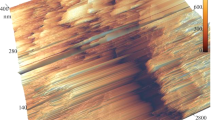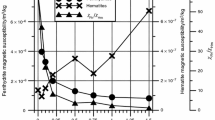Abstract
Synthetic hematites with Al substitutions between 0 and 18 mol % were synthesized at different temperatures and water activities. The cell-edge lengths a for different synthesis conditions decreased linearly with increasing Al substitution. The regression lines, however, had different slopes and intercepts: the series with the highest synthesis temperature (1270 K) had the most negative slope. With increasing Al substitution, the hematites contained increasing amounts of non-surface water. Significant correlations were found between these chemically determined water contents and the deviations of the unit-cell parameters a, c, and V relative to the corresponding 1270 K regression lines. To explain the measured X-ray peak intensities, structural OH had to be included into the theoretical calculations. From intensity ratios normalized to I113, it is possible to determine the structural OH separately from the Al substitution, which can be assessed by the shift of the cell-edge lengths relative to the 1270 K regression lines. The incorporation of Al and OH into the hematite structure induces strain, which was quantified by X-ray diffraction.
Similar content being viewed by others
References
Anand, R. R. and Gilkes, R. J. (1987) The association of maghemite and corundum in Darling Range laterites, Western Australia: Aust. J. Soil Res. 25, 303–311.
Barron, V., Rendon, J. L., Torrent, J., and Serna, C. J. (1984) Relation of infrared, crystallochemical, and morphological properties of Al-substituted hematites: Clays & Clay Minerals 32, 475–479.
Beran, A. (1991) Trace hydrogen in Vemeuil-grown corundum and its colour varieties—An IR spectroscopic study: Eur. J. Mineral. 3, 971–975.
Blake, R. L., Hessevick, R. E., Zoltai, T., and Finger, L. W. (1966) Refinement of the hematite structure: Amer. Mineral. 51, 123–129.
Bom, E. and Paul, G. (1979) Röntgenbeugung am Realkristall: Thieme Verlag, München, 155 pp.
Breithaupt, A. (1847) Handbueh der Mineralogie, Band III: Amoldi, Dresden.
Brill, R. (1932) Röntgenographische Untersuchungen an Eisenkatalysatoren fur die Ammoniak-Synthese: Z. Elektrochemie 38, 669–673.
Cailliere, S., Gatineau, L., and Hénin, S. (1960) Préparation a basse temperature d’hématite alumineuse: Comptes Rendus Acad. Sci. 250, 3677–3679.
Carter, D. L., Heilman, M. D., and Gonzales, C. L. (1965) The ethylene glycol monoethyl ether (EGME) technique for determining soil-surface area: Soil Sci. 100, 409–413.
Catlow, C. R. A., Comish, J., Hennesy, J., and Mackrodt, W. C. (1988) Atomistic simulation of defect structures and ion transport in α-Fe2O3 and α-Cr2O3: J. Amer. Ceram. Soc. 71, 42–49.
Farmer, V. C. (1974) The anhydrous oxide minerals: in The Infrared Spectra of Minerals, V. C. Farmer, ed., Mineralogical Society, London, 539 pp.
Forestier, H. and Chaudron, G. (1925) Points de transformation des solutions solides d’alumine ou de sesquioxyde de chrome dans les sesquioxyde de fer: Comptes rendus Acad. Sci. Paris 180, 1264–1266.
Gregg, S. J. (1953) The production of active solids by thermal decomposition. Part I. Introduction: J. Chem. Soc. IV, 3940–3944.
Gregg, S. J. and Hill, K. J. (1953) The production of active solids by thermal decomposition. Part II. Ferric oxide: J. Chem. Soc. IV, 3945–3951.
Guinier, A. (1963) X-ray Diffraction in Crystals, Imperfect Crystals and Amorphous Bodies: Freeman and Company, San Francisco, 378 pp.
Helgeson, H. C., Delany, J. M., Nesbitt, H. W., and Bird, D. K. (1978) Summary and critique of the thermodynamic properties of rock-forming minerals: Amer. J. Sci. 278A, 1–229.
Hill, R. J. and Madsen, I. C. (1986) The effect of profile step width on the determination of crystal structure parameters and estimated standard deviations by X-ray Rietveld analysis: J. Appl. Crystall. 19, 10–18.
Hsu, P.H. (1963) Effect of initial pH, phosphate, and silicate on the determination of aluminum with aluminon: Soil Sci. 96, 230–237.
Janik, L. M. and Raupach, M. (1977) An iterative, leastsquares program to separate infrared absorption spectra into their component bands: CSIRO Div. of Soils Tech. Paper 35, 1–37.
Klug, H. P. and Alexander, L. E. (1974) X-Ray Diffraction Procedures for Polycrystalline and Amorphous Materials: J. Wiley and Sons, New York, 966 pp.
Königsberger, J. and Reichenheim, O. (1906) Ueber die Elektrizitätsleitung einiger natürlich kristallisierter Oxyde and Sulfide und des Graphits: N. Jb. Min. Geol. Pal. 1906
Kosmas, C. S., Franzmeier, D. P., and Schulze, D. G. (1986) Relationship among derivative spectroscopy, color, crystallite dimensions and A1 substitution of synthetic goethites and hematites: Clays & Clay Minerals 34, 625–634.
Koutler-Anderson, E. (1953) The sulfosalicylic method for iron determination and its use in certain soil analysis: Ann. Roy. Agric. Sweden 20, 297–308.
Lindsay, W.L. (1979) Chemical Equilibria in Soils: J. Wiley & Sons, New York, 449 pp.
Mackrodt, W. C., Davey, R. J., Black, S. N., and Docherty, R. (1987) The morphology of α-Al2O3 and α-Fe2O3: The importance of surface relaxation: J. Cryst. Growth 80, 441–446.
Murad, E. (1984) High-precision determination of magnetic hyperfine fields by Mossbauer spectroscopy using an internal standard: J. Phys. E. Sci. Instrum. 17, 736–737.
Okamoto, G., Furuichi, R., and Sato, N. (1967) Chemical reactivity and electrical conductivity of hydrous ferric oxide: Electrochim. Acta 12, 1287–1299.
Passerini, L. (1930) Soluzione solide, isomorfismo e simmorfismo tra gli ossidi dei metalli trivalenti. I sistema: Al2O3-Cr2O3; Al2O3-Fe2O3: Cr2O3-Fe2O3: Gazz. Chim. Ital. 60, 544–558.
Perinet, G. and Lafont, R. (1972) Sur les parametres cristallographiques des hematites alumineuses: Comptes Rendus Acad. Sci. Paris 275 C, 1021–1025.
Rochester, C. H. and Topham, S. A. (1979) Infrared study of surficial hydroxyl groups on haematite: J. Chem. Soc., Faraday Trans. I 75, 1073–1088.
Schulze, D. G. (1982) The identification of iron oxides by differential X-ray diffraction and the influence of aluminum substitution on the structure of goethite: Ph.D. thesis, Technische Universitat Munchen, University Microfilms International, Ann Arbor, Michigan, 167 pp.
Schwertmann, U. (1964) DifferenzierungderEisenoxidedes Bodens durch photochemische Extraktion mit saurer Ammoniumoxalat-Lösung: Z. Pflanzenernähr. Bodenkde. 105, 194–202.
Schwertmann, U. (1984) Aluminiumsubstitution in pedogenen Eisenoxiden—eine Übersicht: Z. Pflanzenernähr. Bodenkde. 147, 385–399.
Schwertmann, U. (1988) Goethite and hematite formation in the presence of clay minerals and gibbsite at 25°C: Soil Sci. Soc. Amer. J. 52, 288–291.
Schwertmann, U., Fitzpatrick, R. W., Taylor, R. M., and Lewis, D. G. (1979) The influence of aluminium on iron oxides. Part II. Preparation and properties of Al-substituted hematites: Clays & Clay Minerals 27, 105–112.
Stanjek, H. (1987) The formation of maghemite and hematite from lepidocrocite and goethite in a Cambisol from Corsica: Z. Pflanzenernähr. Bodenkde. 150, 314–318.
Stanjek, H. (1991) Aluminium- und Hydroxylsubstitution in synthetischen und natürlichen Hämatiten: Ph.D. thesis, Technische Universität München, Maria Leidorf, Buch am Erlbach, 200 pp.
von Steinwehr, H. E. (1967) Gitterkonstanten im System α-(Al,Fe,Cr)2O3 und ihr Abweichen von der Vegardregel: Z. Kristallographie 125, 377–403.
Wefers, K. (1967) Phasenbeziehungen im System Al2O3-Fe2O3-H2O: Erzmetall 20, 13–19.
Wolska, E. (1977) Die Bedeutung von Aluminiumspuren im Alterungsvorgang von amorphem Eisen(III)-hydroxid fur die Eliminierung der Goethitphase: Monatshefte Chemie 108, 819–828.
Wolska, E. (1981) The structure of hydrohematite: Z. Kristallographie 154, 69–75.
Wolska, E. and Szajda, W. (1985) Structural and spectroscopic characteristics of synthetic hydrohematite: J. Mater. Sci. 20, 4407–4412.
Author information
Authors and Affiliations
Rights and permissions
About this article
Cite this article
Stanjek, H., Schwertmann, U. The Influence of Aluminum on Iron Oxides. Part XVI: Hydroxyl and Aluminum Substitution in Synthetic Hematites. Clays Clay Miner. 40, 347–354 (1992). https://doi.org/10.1346/CCMN.1992.0400316
Received:
Accepted:
Published:
Issue Date:
DOI: https://doi.org/10.1346/CCMN.1992.0400316




